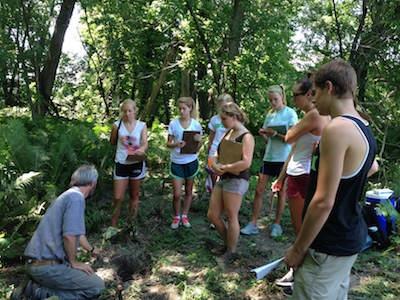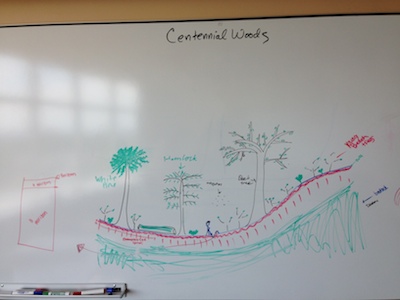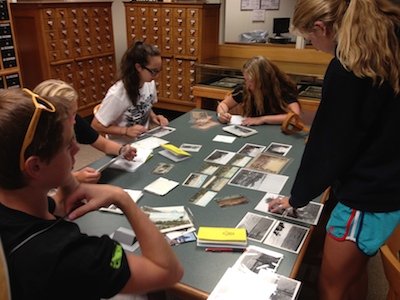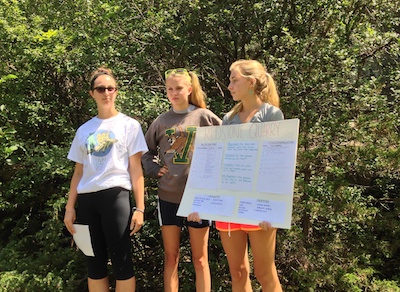Place-based Learning
Sustainable Landscape Ecology: UVM High School Summer Academy
High school students enrolled in the two-week intensive UVM Summer Academy course "Sustainable Landscape Ecology" explored the natural places around Burlington, using the Burlington Geographic focal areas as their study centers. The course was served as a guided inquiry through the various layers of the landscape, comparing and contrasting the geology, soils, ecology, and human land-use patterns of the Burlington Geographic focal areas, with an added emphasis on sustainable land-use practices in these urban-wild intersections. On the first day, students ventured to Centennial Woods for practice in "reading the landscape," learning how to conduct a basic forest plot inventory and how to interpret a soil pit.
 After comparing their data and debriefing this experience in the classroom, the students were tasked with conducting their first group ecological inventory at the Intervale. Students also met with key community members associated with the Intervale Center in order to learn about the sustainable land management and farming occurring along the river.When asked about their own ideas for sustainable land us in the Intervale, it became clear to the students that there was certainly risk and reward to organic farming along the floodplain, but that it would serve as a wonderful way provide food to the local restaurants and schools.
After comparing their data and debriefing this experience in the classroom, the students were tasked with conducting their first group ecological inventory at the Intervale. Students also met with key community members associated with the Intervale Center in order to learn about the sustainable land management and farming occurring along the river.When asked about their own ideas for sustainable land us in the Intervale, it became clear to the students that there was certainly risk and reward to organic farming along the floodplain, but that it would serve as a wonderful way provide food to the local restaurants and schools.
Interspersed with the field site investigations were short lectures about the geologic history of Vermont, the dynamics of rivers, and the scientific inquiry process. At each site, the students oriented themselves with their traveling maps of Burlington and set out to do both qualitative and quantitative assessments of the vegetation. Additionally, a dozen focal tree species were used to guide the comparison of these various landscapes. Students read about the natural history and ecology of the different species, what kinds of soils and shade levels they tolerate, and how quickly they grow after disturbance, and were quizzed on their field identification.
 After their field explorations of Centennial Woods, the Intervale, and Rock Point, the class began taking a comparative approach to their analysis to see if they could find patterns emerging and think about what processes were at play. The class drew out cross-sections of each area visited to represent their understanding of the geology, soils, and vegetation of each. Afterwards, students noted where the group discussed patterns they saw regarding how the underlying geology and soils influenced the natural communities occurring in each distinct area.
After their field explorations of Centennial Woods, the Intervale, and Rock Point, the class began taking a comparative approach to their analysis to see if they could find patterns emerging and think about what processes were at play. The class drew out cross-sections of each area visited to represent their understanding of the geology, soils, and vegetation of each. Afterwards, students noted where the group discussed patterns they saw regarding how the underlying geology and soils influenced the natural communities occurring in each distinct area.
 In the second week of the course, the group traveled to the Burlington waterfront for an added focus on heavily human-intervened landscapes and to think about what sustainable land use looks like for a man-made ecosystem (the group learned that the entirety of the waterfront park area was created by fill in the early 20th century). In similar stride to the Burlington High School course about "Envisioning the Waterfront" the Summer Academy students met with UVM archivists to look over maps and historic photos that could re-create the dynamic cultural history of the waterfront - from its use as a major port and railway station for lumber, to the more recent oil drums dotting the landscape, to the creation of waterfront park.
In the second week of the course, the group traveled to the Burlington waterfront for an added focus on heavily human-intervened landscapes and to think about what sustainable land use looks like for a man-made ecosystem (the group learned that the entirety of the waterfront park area was created by fill in the early 20th century). In similar stride to the Burlington High School course about "Envisioning the Waterfront" the Summer Academy students met with UVM archivists to look over maps and historic photos that could re-create the dynamic cultural history of the waterfront - from its use as a major port and railway station for lumber, to the more recent oil drums dotting the landscape, to the creation of waterfront park.
 For their final task, the class was divided up into teams to evaluate a new location using the tools and frameworks they'd acquired through the course. Students explored the areas of Potash Brook, Oakledge Park, and the Redstone Quarry. Each team spent time at their location looking into the vegetation and soils before creating a pattern question to look into. With the help of the instructors, students designed an investigation to see if their pattern observation held true or not, and then presented out their findings about the ecology and possible sustainable land use practices they envisioned for their site. As a final paper, each student also wrote up their own comparative ecology essay about the Burlington landscape and what they learned about the connections between geology, soils, ecology, and land use.
For their final task, the class was divided up into teams to evaluate a new location using the tools and frameworks they'd acquired through the course. Students explored the areas of Potash Brook, Oakledge Park, and the Redstone Quarry. Each team spent time at their location looking into the vegetation and soils before creating a pattern question to look into. With the help of the instructors, students designed an investigation to see if their pattern observation held true or not, and then presented out their findings about the ecology and possible sustainable land use practices they envisioned for their site. As a final paper, each student also wrote up their own comparative ecology essay about the Burlington landscape and what they learned about the connections between geology, soils, ecology, and land use.



